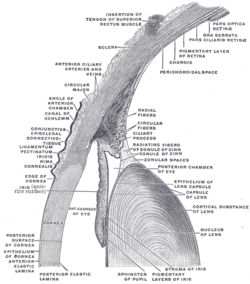| Capsule of lens | |
|---|---|
 | |
| Details | |
| Identifiers | |
| Latin | capsula lentis |
| MeSH | D007903 |
| TA98 | A15.2.05.007 |
| FMA | 58881 |
| Anatomical terminology | |


The lens capsule is a component of the globe of the eye.[1] It is a clear elastic basement membrane similar in composition to other basement membranes in the body. The capsule is a very thick basement membrane[2] and the thickness varies in different areas on the lens surface and with the age of the animal. It is composed of various types of fibers such as collagen IV,[3] laminin, etc.[4][5][6] and these help it stay under constant tension.[7] The capsule is attached to the surrounding eye by numerous suspensory ligaments and in turn suspends the rest of the lens in an appropriate position. As the lens grows throughout life so must the capsule. Due to the shape of the capsule, the lens naturally tends towards a rounder or more globular configuration, a shape it must assume for the eye to focus at a near distance. Tension on the capsule is varied to allow the lens to subtly change shape to allow the eye to focus in a process called accommodation.
Early in embryonic development the lens capsule is highly vascularized but later during embryo development becomes avascular and transparent, serving as a diffusion barrier helping to protect the lens. It is permeable to low molecular weight compounds,[8] but restricts the movement of larger things like bacteria, viruses and large colloidal particles.[9] As the capsule contains the lens, it is clinically significant in regard to surgery of the lens. For example, it is used to contain new artificial lenses implanted after cataract surgery.
- ^ "Mode of Discovering the Proper Capsule of the Crystalline Lens". The London Medical and Physical Journal. 34 (202): 453–454. December 1815. PMC 5594332. PMID 30493699.
- ^ Yanoff, Myron. (2009). "Lens". Ocular pathology. Sassani, Joseph W. (6th ed.). Edinburgh: Mosby/Elsevier. ISBN 978-0-323-04232-1. OCLC 294998596.
- ^ DISCHE, Z; ZELMENIS, G (April 1965). "The Content and Structural Characteristics of the Collagenous Protein of Rabbit Lens Capsules at Different Ages". Investigative Ophthalmology. 4: 174–80. PMID 14283010.
- ^ Mohan, PS; Spiro, RG (25 March 1986). "Macromolecular organization of basement membranes. Characterization and comparison of glomerular basement membrane and lens capsule components by immunochemical and lectin affinity procedures". The Journal of Biological Chemistry. 261 (9): 4328–36. doi:10.1016/S0021-9258(17)35665-X. PMID 3512568.
- ^ Halfter, W; Candiello, J; Hu, H; Zhang, P; Schreiber, E; Balasubramani, M (January 2013). "Protein composition and biomechanical properties of in vivo-derived basement membranes". Cell Adhesion & Migration. 7 (1): 64–71. doi:10.4161/cam.22479. PMC 3544788. PMID 23154404.
- ^ Danysh, BP; Duncan, MK (February 2009). "The lens capsule". Experimental Eye Research. 88 (2): 151–64. doi:10.1016/j.exer.2008.08.002. PMC 2674021. PMID 18773892.
- ^ Fisher, RF (March 1969). "Elastic constants of the human lens capsule". The Journal of Physiology. 201 (1): 1–19. doi:10.1113/jphysiol.1969.sp008739. PMC 1351628. PMID 5773553.
- ^ Kastner, Christian; Löbler, Marian; Sternberg, Katrin; Reske, Thomas; Stachs, Oliver; Guthoff, Rudolf; Schmitz, Klaus-Peter (October 2013). "Permeability of the Anterior Lens Capsule for Large Molecules and Small Drugs". Current Eye Research. 38 (10): 1057–1063. doi:10.3109/02713683.2013.803288. PMID 23885713. S2CID 21090856.
- ^ Cite error: The named reference
:0was invoked but never defined (see the help page).
© MMXXIII Rich X Search. We shall prevail. All rights reserved. Rich X Search
